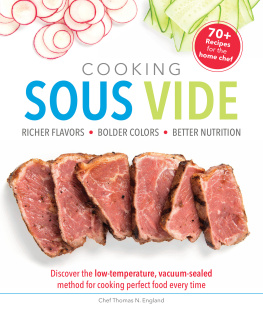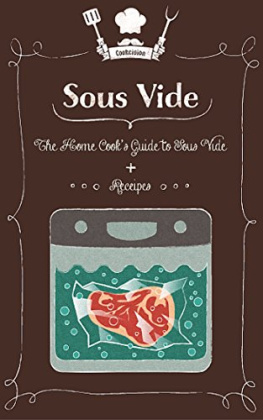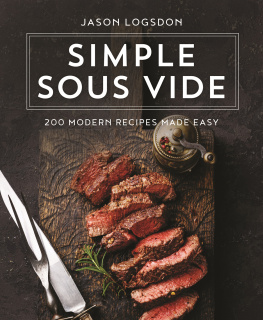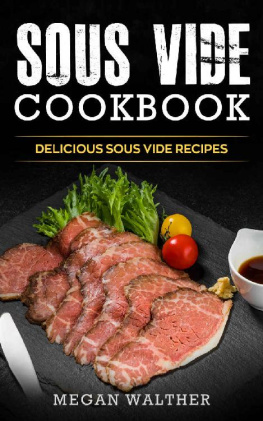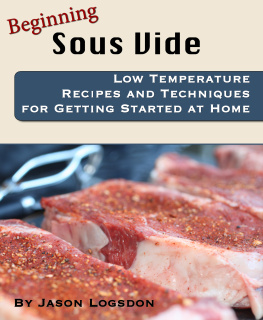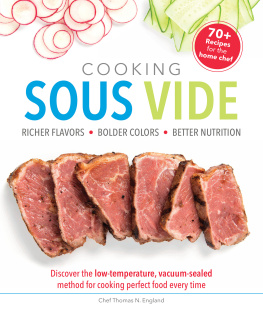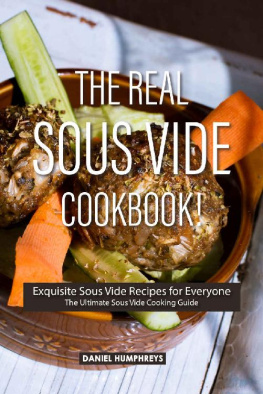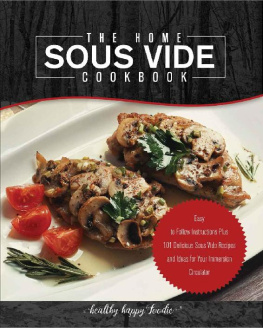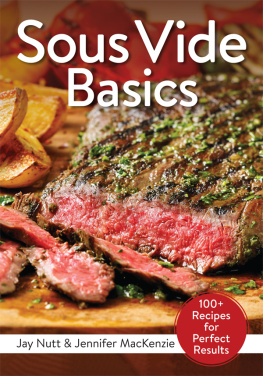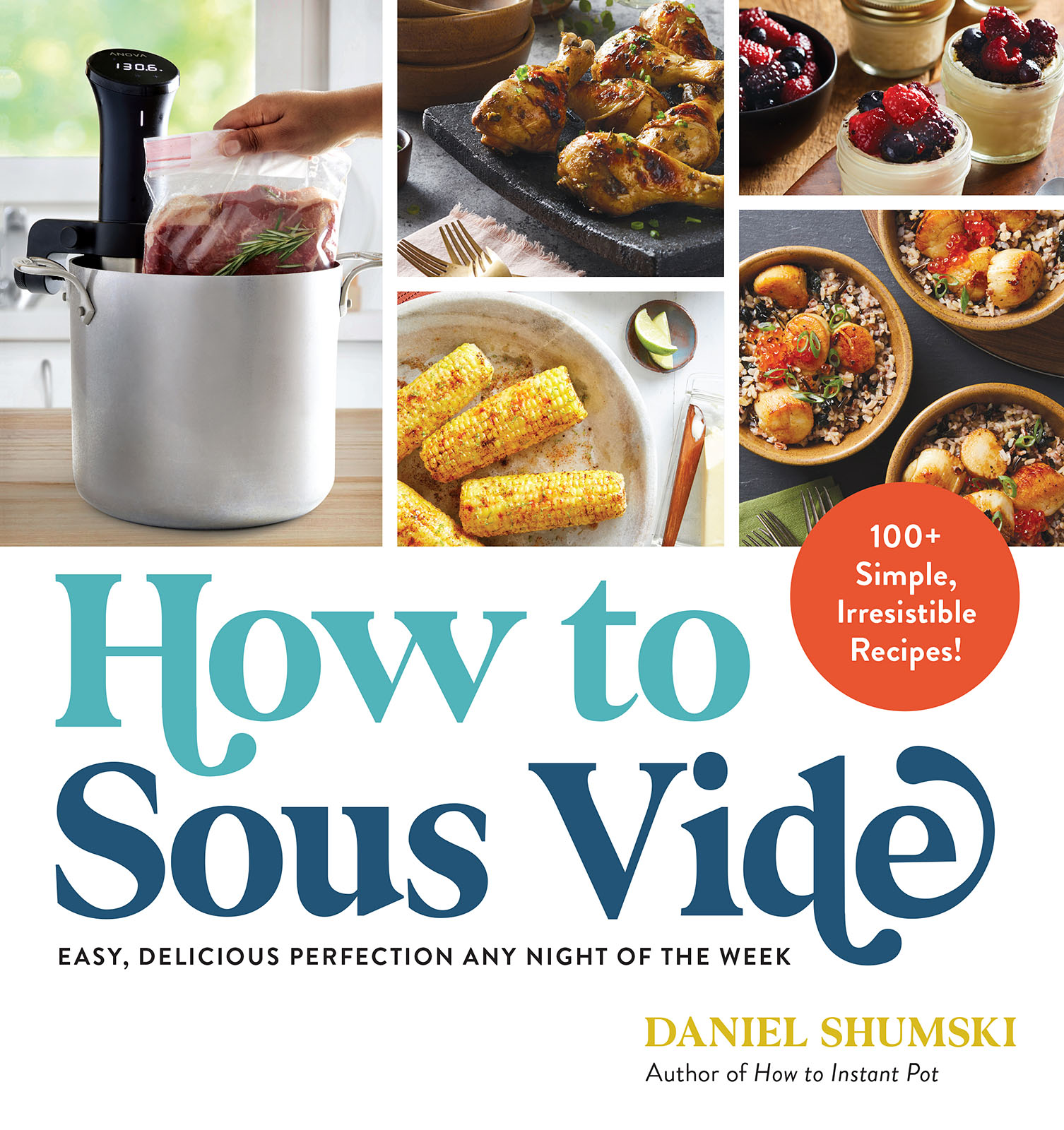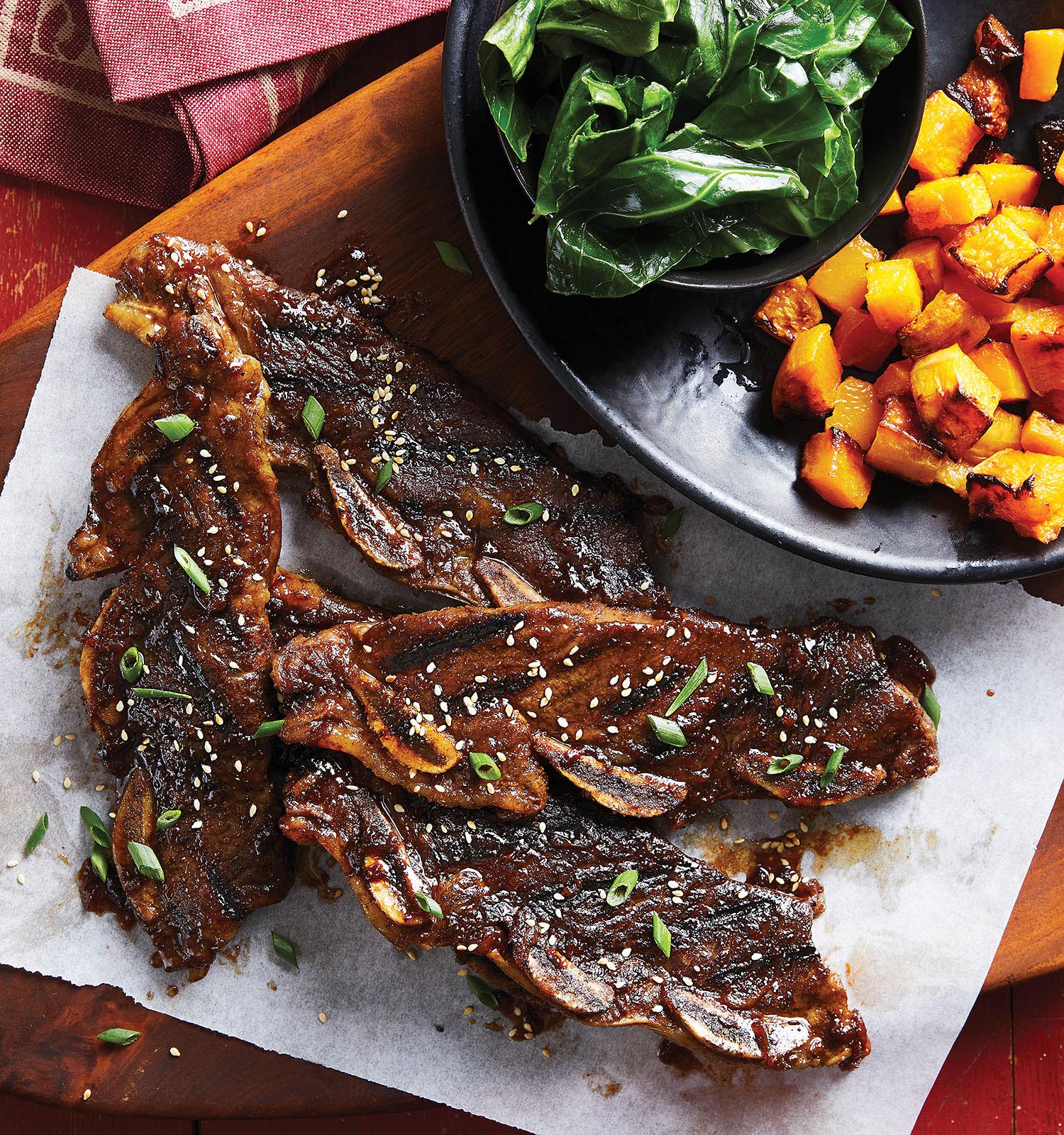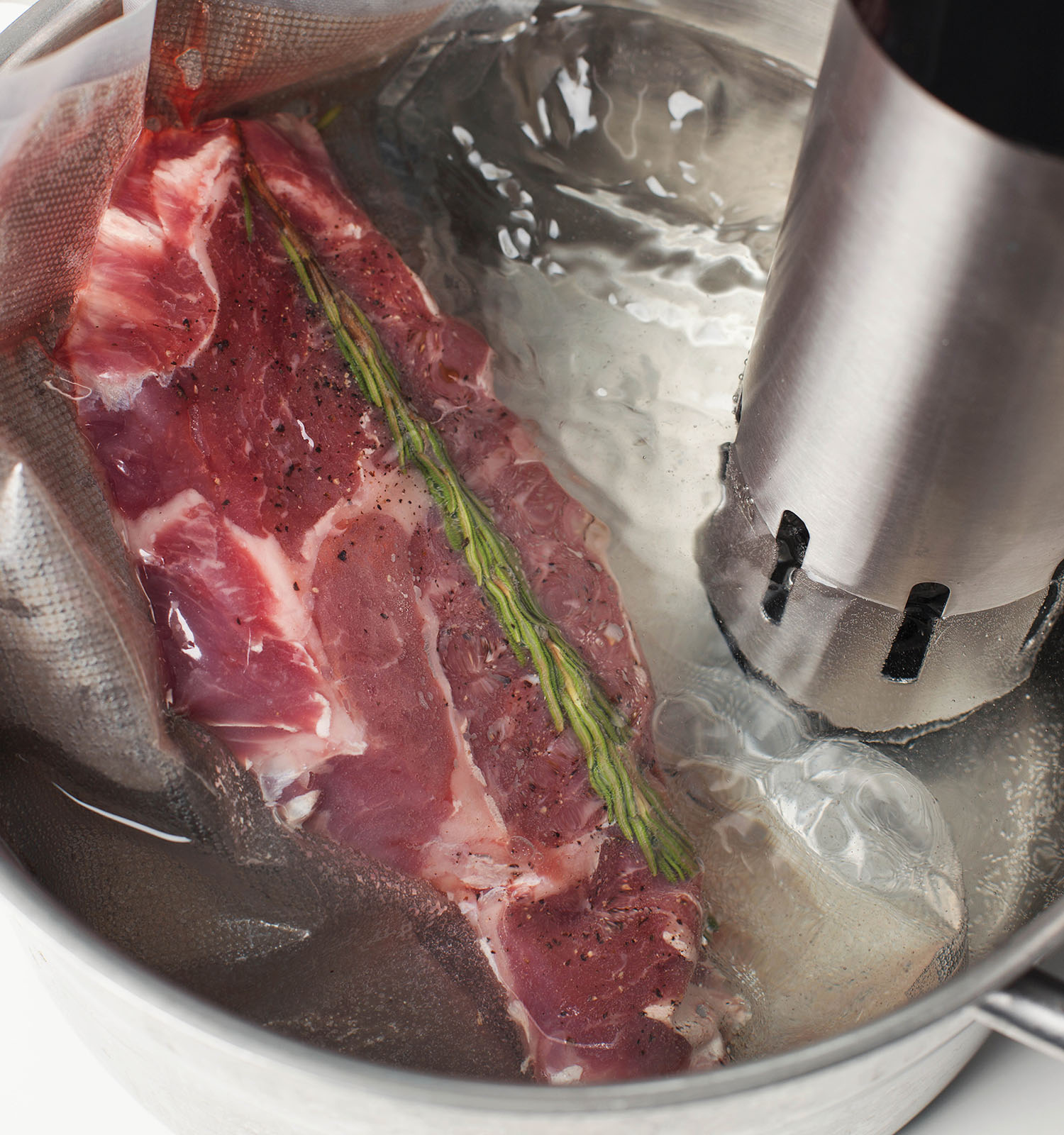Chapter 1
Sous Vide Basics
T hough you may not have known it, youve probably had food cooked sous vide. Restaurants use it to cook food ahead of time and to perfectionhelping to manage the last-minute scramble for ordersand the technique has gradually spread from there. Not long ago, sous vide equipment became accessible in price and in availability, with companies offering their gear to the home cook. The technique started in fine dining and has gradually expanded from rarefied kitchens to more humble eateries even to the coffee shop on the corner. And now to you.
Sous Vide Cooking in a Nutshell
How to describe sous vide cooking in a single breath: Food is sealed in a watertight package with the air removed and then cooked in a water bath at a precise temperature.
Okay, now a few more breaths: All of this is made possible by a device known as a sous vide circulator or immersion circulator, also called a stick, wand, or simply a sous vide. The circulator is simple. It consists of a temperature gauge, a heating element, and a motor that pushes around the water for even heating.
Cooking sous vide means embracing reliable, replicable, and delicious results. Were talking meat that is cooked to astoundingly even perfection, where a steak done to medium is the same rosy shade from edge to edge. Sous vide cooking spares delicate seafood and vegetable dishes from overcooking.
While a lot of the buzz surrounding sous vide focuses on cooking meatjustifiably!it also opens up a new supporting cast for your meals. is such a great note with which to finish a dish.
And what about dessert? Cheesecake, ice cream, crme brleenough said! (Okay, not quite enough said; see .)
And maybe theres a misconception that sous vide cooking is complicated, possibly because its unfamiliar or because it got its start in fancy restaurant kitchens. But in truth, its easy. Once more for the people at the back: Its easy! Once you get over the gentle learning curve, you can do it in your sleep. (Perhaps literally if the recipe takes more than 8 hours.) This book shows you how and, even better, will show you why with recipes that highlight the best of sous vide cooking.
The Advantages of Sous Vide Cooking
Precision: Many sous vide circulators regulate temperature to within one-half of one degree Fahrenheit. Your oven cant manage that degree of precision. (Ovens might cycle within a band of 30F, 40F, or 50F, and thats assuming theyre even calibrated correctly in the first place.) Try setting a pot of water on the stovetop to, say, simmer at precisely 200.5F; it wont happen. Sous vides precision ties in nicely to the next point.
Predictability: Its nice to have unpredictability in the sense of someone whisking you away on a surprise vacation. Its less nice to have unpredictability in the sense of overcooking your expensive steak, even though you thought you did it the same way as last time. Sous vides precision and consistency combine to eliminate that room for error.
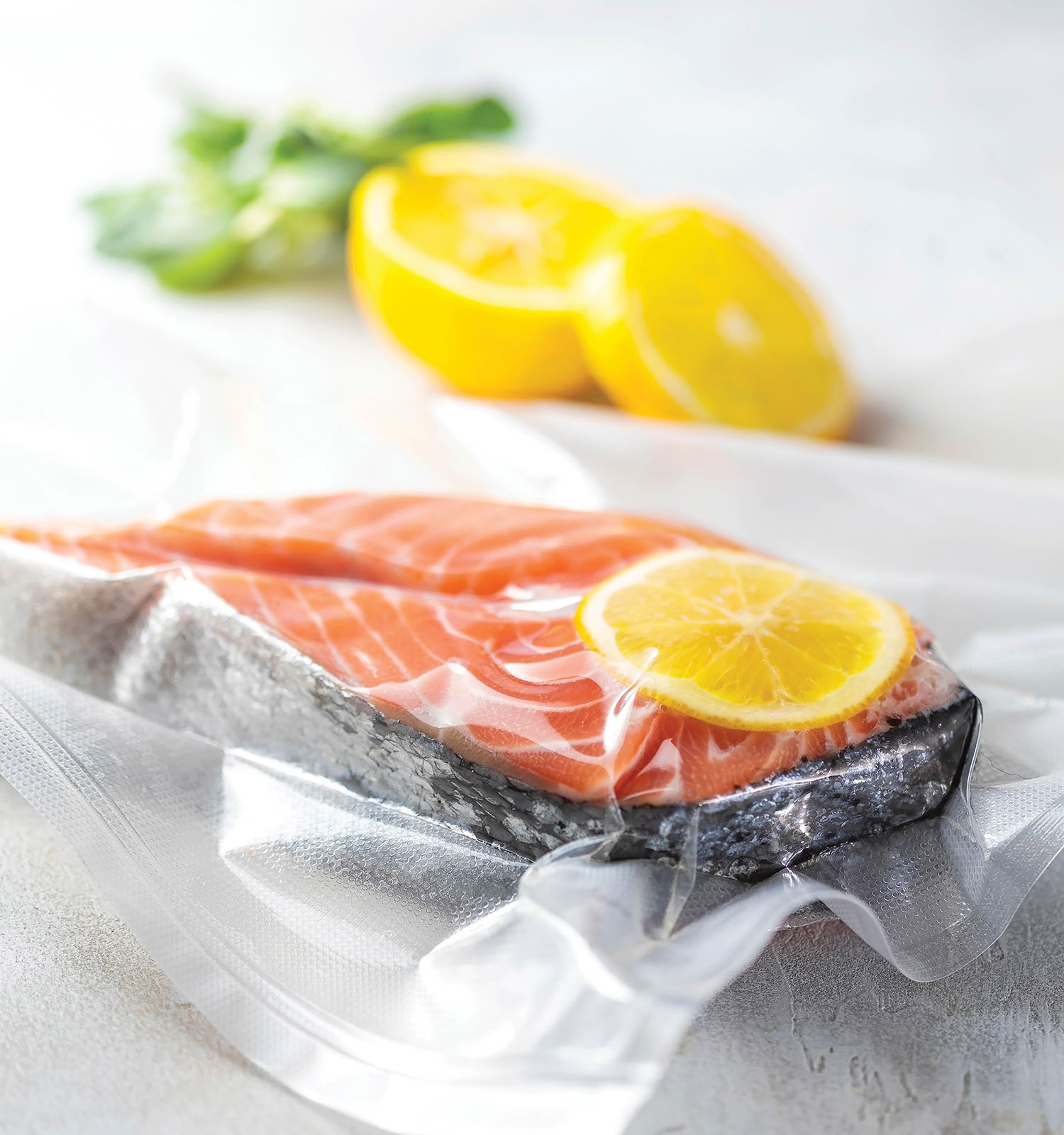
Forgiveness: Five more minutes wont matter. Ten more minutes wont matter either. Half an hour? Eh, it probably wont matter. There arent too many cooking methods that let you say that, but sous vide timing is very flexible. While food might start to break down and change texture after the recommended times, rarely will a short stretch of time be the make-or-break for dinner success. Try that with the pasta that turned to mush after 3 too many minutes or the pizza that burnt while you refreshed your social media feed. (That like was lovely. Was it worth a pizza?)
Ease: This is not just a lack of complication, though sous vide cooking is very straightforward once you know the deal. The ease also comes from the ability of the chef to deep-breathe and leave behind anxiety about dinner. Impressive results asidefor just a secondthats worth a lot, regardless of the cooking method.
Time: While sous vide cooking can take a whilemaybe a few hours, maybe more in some casesthat time is almost all passive. Theres no watching, stirring, or poking involved. Sous vide cooking allows you to cook while you do the laundry or, um, write a cookbook.
Novelty: Look, youre interested in new cook-ing methods or you wouldnt be reading this. Since our cave-dwelling ancestors discovered fire and first submitted it to reviews from the cave public at large (not hot enough!; too hot!; etc.), there have only been so many new cooking methods. Sous vide qualifies.
Practicality and Preparation: Sous vide cooking opens up possibilities for portioning and precooking. You have many options: Refrigerate or freeze the sous vide cooked meat and then finish it later. Freeze portions of meat already seasoned and sealed, ready for their sous vide bath. (Yes, you can put the frozen and prepacked sous vide packets directly into the bath!) Get a jump on tomorrows dinner or this weekends barbecue by cooking a few chicken pieces for tonight and a few more later on.
Impressiveness: Brag a little. Youve earned it. When I mention Ive cooked something using sous vide, the response is usually either Whos that? or Whats that? Dinner isnt always for lingering and discussing, but if you want a talking point, sous vide delivers when everyone tastes the results and wants to know more. Or you can keep it a secret, and let everyone be wowed by your powers to cook a steak consistently and perfectly. I can see it going either way.
Is Cooking Sous Vide Safe?
Sous vide cooking is safe. But its different from conventional cooking, and it flouts some of the rules weve learned as careful cooks. Lets take a closer look at the safety of sous vide.
Temperatures
Many of us have perhaps had certain food safety temperatures drilled into our heads. Do the temperatures 165F for chicken, 160F for ground beef, and 145F for pork ring a bell? Those are the USDAs minimum recommended internal temperatures. (In the case of pork, with three minutes of resting time mandated.) There is a very good reason for those temperaturesand a very good reason that they dont apply to sous vide cooking.
Those temperature benchmarks represent what I would call the nuke from space temperaturesthose needed to instantly reduce bacteria to a safe level. Once the foods reach those temperatures, the USDA doesnt need to worry about how long the food has spent there; its safe. The USDA simply does not expect that you will have a sensitive device regulating the cooking temperature to within one-half of a degree over the course of several hours. But you do! You have a sous vide circulator. So a new range of temperatures comes into play. The bottom line is that foods can cook at lower temperatures as long as they stay there for specified periods of time, and as long as they stay out of the temperature danger zone. For more details on this, see .
Sous Vide Best Practices
Diligently follow the recipes and guidelines in this cookbook to stay safe. Heres what youre up against:


